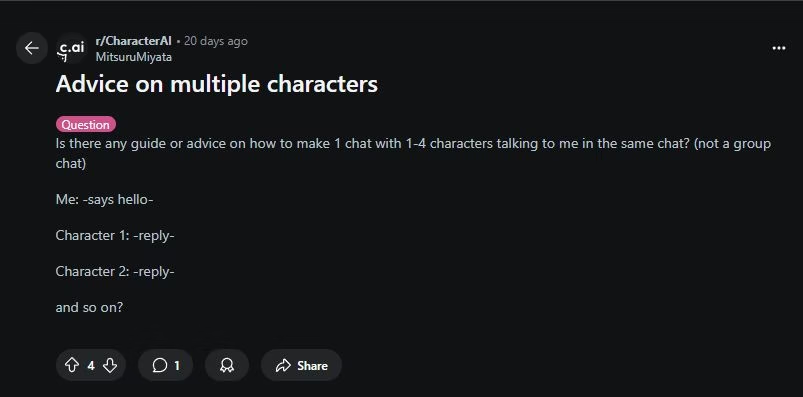How I Got Multiple Characters to Work in One Character AI Chat
I wanted to create a chat where multiple characters could talk to me in the same space—kind of like hosting a dinner party in my phone, except no one’s fighting over dessert. Sounds simple, right? Yeah, I thought so too.
Turns out, Character AI doesn’t exactly make that straightforward. It’s not built for clean multi-character interaction in a single chat, but with some clever formatting tricks and a little trial and error, I figured out how to make it work without my AI characters sounding like they’ve all taken the same improv class.
Why Character AI Doesn’t Naturally Support Multi-Character Chats
Character AI is built around the idea of one-on-one conversations. So when you try to toss three or four characters into the mix, things can start to get weird—fast.
You’ll notice replies sometimes blend together, responses overlap, or one character talks way too much while the others vanish into the void. That’s because the system isn’t designed to manage multiple character “voices” in a single thread unless you give it clear instructions.
I learned this the hard way when I tried to have a friendly chat with two knights and a dragon. Long story short, the dragon became the group moderator and the knights started quoting Shakespeare. Not ideal.
To get around that, you need to guide the AI with a structured approach. That starts with formatting.
The Formatting Trick That Actually Works
Here’s what made the biggest difference: formatting the example messages inside your character’s definition using a script-style layout—with spacing that actually matters.
Let’s break it down.
If you want the AI to handle multiple characters in one reply, use a format like this when writing example messages:
That little space before each new character line? It’s doing the heavy lifting. Without it, Character AI interprets each line as a separate example, which causes all kinds of chaos when it generates responses. You’ll end up with broken flow, repeated lines, or characters who just stop talking.
Do NOT format like this:
Looks fine to the human eye, but to Character AI, it’s a mess. Trust me, that missing space is the difference between a smooth group convo and a digital shouting match.
Common Mistakes That Break Multi-Character Chats
I made just about every mistake you can imagine before I figured out what actually works.
Here are the ones that caused the most chaos:
-
Forgetting the space before each character’s line
This one’s a deal-breaker. Without it, Character AI thinks you’re starting a new message instead of continuing the same one. -
Naming characters inconsistently
One moment it’s “Knight One,” the next it’s “Sir Bob.” The AI gets confused fast if you’re not consistent with names in your example messages. -
Writing too much in one example message
If you cram a full monologue from every character into a single example, the AI gets overwhelmed and starts skipping or merging responses. -
Not making it clear who you are in the chat
If your character definition doesn’t show the user talking (e.g., “Me: -asks a question-“), the AI may skip your part or have characters reply to each other instead of to you. -
Expecting perfect balance
The AI can sometimes favor one character over the others. If one of them keeps hogging the spotlight, you might need to tweak the example messages to even it out.
How to Make Conversations Feel More Natural (And Less Like a Play Script)
Once the formatting is handled, the next challenge is making these chats sound like real back-and-forth conversations, not a high school drama rehearsal.
Here’s what helped me:
-
Give each character a distinct voice
Think quirks, slang, or different ways of speaking. If everyone sounds the same, it feels robotic. One of my bots always responds with overly formal language. Another one? Total sarcasm gremlin. -
Use shorter, punchier example replies
You don’t need a whole paragraph from each character. Two lines max keeps the pacing snappy. -
Add reactions, not just dialogue
Stuff like shrugs, laughs awkwardly, or glances at you helps the AI visualize the scene. That also reminds it that there are multiple people in the room. -
Break the “turn-taking” when it makes sense
Sometimes it’s more natural if one character interrupts or reacts quickly before another finishes. If every response is too orderly, it feels fake.
Once I started doing this, my chats went from clunky roleplay to something that felt a lot more like a real, weird little group conversation. Occasionally chaotic? Sure. But at least it wasn’t boring.
What to Do When the AI Starts Messing Up Again
Even after you get everything set up, Character AI has its moments. Sometimes it forgets who’s in the chat. Other times it suddenly decides one of your characters is now mute, or everyone starts responding exactly the same way. It’s like the AI just gave up and said, “You figure it out.”
Here’s what I do when things go sideways:
-
Restart the thread
If the conversation gets too messy or repetitive, starting fresh usually helps. Just copy your formatting over and try again. -
Adjust your character definitions
Sometimes you need to add a few more example messages—or tweak how you describe the characters. Small changes can make a big difference. -
Remind the AI mid-chat
You can narrate in the chat, like:Me: Let's hear from Character 2 now.
orMe: Hey, Character 3, you’ve been quiet.
It usually nudges the bot back into shape. -
Keep your expectations realistic
The AI isn’t perfect, and it probably won’t handle three or four characters flawlessly every time. But if the personalities are clear and the structure holds, it’ll usually stay on track well enough for some fun, meaningful interaction.
If all else fails, take a break, breathe, and remind yourself that even group chats with real people can go off the rails. AI’s just keeping it realistic.
When to Use Alternatives Like Candy AI
Let’s be honest: Character AI does a lot of things well, but juggling multiple personalities in one chat isn’t exactly its specialty.
If you find yourself spending more time wrestling the formatting than actually enjoying the conversation, it might be worth checking out other tools.
I’ve had some luck with Candy AI—it’s more flexible and doesn’t throw a tantrum when you want a bit more control. It’s not perfect, but it lets you set the vibe and structure in a way that doesn’t require as much babysitting.
Some people also experiment with other roleplay-friendly chat platforms, but again, the trick is finding one that doesn’t try to rewrite your scene halfway through like it’s got directorial control.
Final Thoughts
Setting up multiple characters in a single Character AI chat isn’t exactly plug-and-play, but it is doable with a bit of structure and patience.
Once I stopped expecting it to behave like a group Zoom call and started treating it more like a staged scene—with clear cues and formatting—it finally started clicking.
Sure, it still glitches now and then. One time, all three of my characters responded in unison like a haunted choir. But for the most part, using the script-style format and being consistent with character tone has made a huge difference.
And if it ever feels like more effort than fun, other platforms like Candy AI might suit your style better.
No coding required. Just a little formatting magic, and you can have your fantasy crew, sci-fi squad, or chaos trio talking to you like they’ve known each other (and you) for years.

